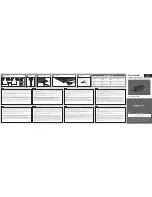
3
SECTION 1
3.
Cover close switch
When you open or close the LCD display, this switch automatically puts the computer into standby
(suspending operation) mode, resumes system operation, or turns off the backlight of the LCD
display.
4.
SUS/RES (Suspend/Resume) switch
Used to turn on your computer, to put it into standby (suspending operation) mode, or to resume
system operation.
5.
Keyboard
Allows you to type in letters and figures and to give instructions to the computer.
6.
Flat Point
Used to control the mouse pointer.
7.
One-touch buttons
Used to start applications and to play music CDs.
8.
Status indicator LCD
Displays the operating status of the computer.
9.
Speakers
A sound output device of the computer
10. CoolScroll button
Used to scroll up and down the active window. By pressing the center, you can start an application
or operate Internet Explorer.
Critical Point
For some applications, you cannot use the CoolScroll button to scroll up and down windows.
Critical Point
About the characteristics of LCD displays
For reasons of characteristics specific to LCD displays, the following phenomena may occur
but they are not defects in your LCD display.
- The TFT color liquid crystal display (LCD) of you computer consists of more than
2,350,000 pixels (dots), which are arranged in rows and columns through the utilization
of high-level technology. For technical reasons, however, some dots on your LCD display
may not light up or be always lit, but this does not mean that the display is defective.
- There may be a slight difference in color between your LCD display and another LCD
display because of differences in manufacturing condition. Moreover, your LCD display
may produce colors somewhat unevenly because of temperature changes, etc.
















































